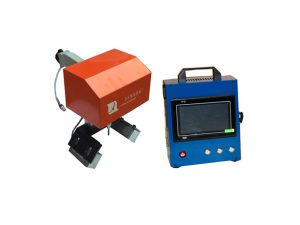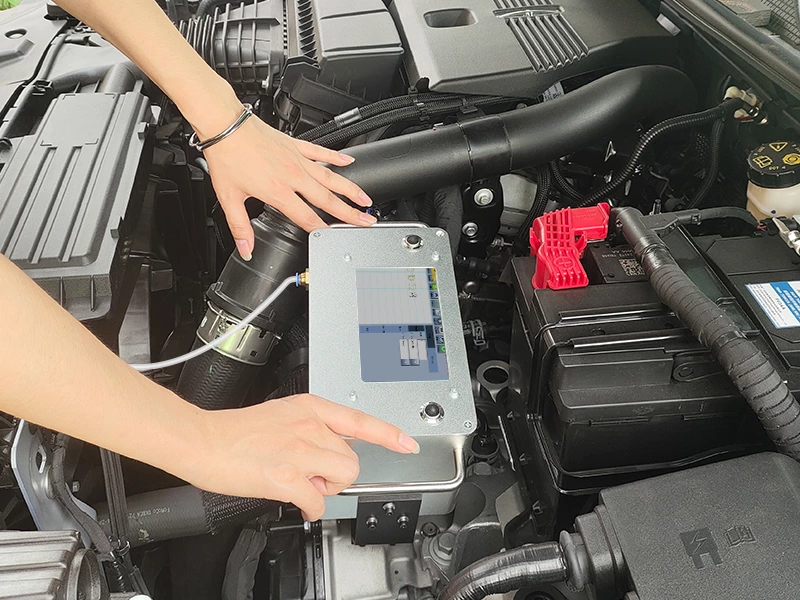Как работает станок для маркировки цилиндров
Машины для маркировки цилиндров являются важнейшими инструментами в различных отраслях промышленности, обеспечивая надежный способ маркировки важной информации на цилиндрических объектах, таких как газовые баллоны, трубы и другие трубчатые материалы. В этой статье мы рассмотрим, что такое маркировка цилиндров, различные типы маркировочных машин, процесс маркировки и отрасли, в которых эти машины обычно используются.
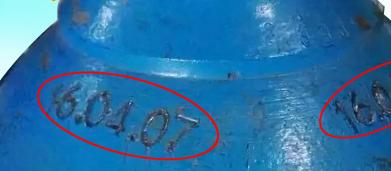
Что такое маркировка цилиндров?
Маркировка цилиндров это процесс нанесения или печати важной информации на цилиндрические объекты, такие как газовые баллоны, трубы и различные промышленные компоненты. Этот метод выполняет несколько жизненно важных функций в различных отраслях промышленности, обеспечивая доступность и читаемость важных данных. Основные аспекты маркировки цилиндров включают:
- Прослеживаемость: Такие маркировки, как серийные номера и штрих-коды, позволяют легко отслеживать каждый баллон на протяжении всего его жизненного цикла, от производства до использования и утилизации. Такая возможность отслеживания крайне важна для управления запасами и соблюдения нормативных требований.
- Информация о безопасности: Маркировка часто включает инструкции по безопасности, идентификацию содержимого и предупреждения об опасности. Для газовых баллонов эта информация крайне важна для предотвращения несчастных случаев и обеспечения безопасного обращения.
- Соответствие нормативным требованиям: Многие отрасли промышленности подчиняются строгим нормам, требующим нанесения на продукцию определенной информации. Соблюдение этих норм помогает предприятиям избежать судебных штрафов и повышает доверие к продукции.
- Обеспечение качества: Маркировка гарантирует соответствие каждого компонента промышленным стандартам и спецификациям. Она обеспечивает быструю справку при проверке качества и составлении графиков технического обслуживания.
- Идентификация бренда: Маркировка также может включать элементы брендинга, такие как логотипы или названия компаний, помогающие обеспечить узнаваемость и лояльность бренда на рынке.
В целом, маркировка цилиндров - это важнейший процесс, который повышает безопасность, соответствие нормативным требованиям и эффективность работы в различных отраслях.
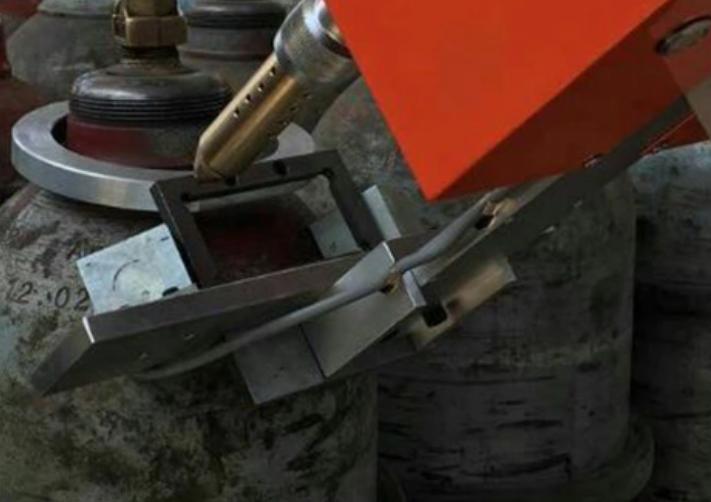
Типы Маркировочная машина для цилиндров
Машины для маркировки цилиндров Различные типы машин предназначены для нанесения долговечной и разборчивой маркировки на цилиндрические поверхности и соответствуют различным материалам, методам маркировки и отраслевым требованиям. Вот более подробный обзор наиболее часто используемых типов машин для маркировки цилиндров:
1. Лазерные маркировочные машины
Машины для лазерной маркировки являются одним из самых популярных и передовых вариантов маркировки цилиндров. Эти машины используют высокоинтенсивные лазерные лучи для вытравливания или гравировки текста, штрих-кодов, серийных номеров и других маркировок на поверхности цилиндра. Лазерный луч создает постоянные, высококонтрастные метки, устойчивые к выцветанию, истиранию и воздействию окружающей среды.
- Преимущества: Лазерная маркировка обеспечивает исключительную точность, высокую скорость и позволяет наносить маркировку на широкий спектр материалов, включая металлы, пластики, керамику и стекло. Кроме того, она бесконтактна, что снижает износ оборудования и обеспечивает высокую скорость обработки.
- Ограничения: Лазерные маркировочные машины могут иметь высокую начальную стоимость, особенно мощные промышленные модели. Кроме того, некоторые материалы могут потребовать специальных настроек или подготовки для обеспечения оптимального качества маркировки.
2. Маркировочные машины
Маркировочные машины являются популярным выбором для маркировки металлических цилиндров, известных своей долговечностью и адаптивностью. В этом методе используется щуп, который быстро ударяет по поверхности цилиндра, создавая последовательность небольших углублений, образующих текст, цифры и даже сложные узоры. В результате получается стойкая, прочная маркировка, хорошо подходящая для работы в сложных условиях.
- Преимущества: Точечная маркировка - это экономичное, универсальное и долговечное решение. Благодаря физическому вдавливанию в поверхность, маркировка обладает высокой износостойкостью, что делает ее идеальным решением для промышленных объектов, где маркировка может часто использоваться или подвергаться абразивному воздействию.
- Ограничения: Точечная маркировка обычно отличается меньшей точностью по сравнению с лазерной, что может быть недостатком для приложений, требующих сложной детализации. Кроме того, этот процесс может быть несколько шумным и, как правило, лучше всего подходит для металла или других твердых материалов.
3. Струйные маркировочные машины
Каплеструйные маркировочные машины - это гибкий вариант, использующий чернила для печати на поверхности цилиндра. Они работают аналогично стандартным струйным принтерам: чернила распыляются через сопло для создания маркировки на цилиндре. Этот метод часто используется для временной маркировки или в тех случаях, когда требуется часто менять маркировку.
- Преимущества: IМаркировка nkjet - это быстрота, простота настройки и гибкость, позволяющая быстро менять напечатанную информацию. Она совместима с широким спектром материалов и может наносить маркировку и на неметаллические поверхности.
- Ограничения: Струйная маркировка не так долговечна, как другие методы маркировки, и со временем может стираться, особенно в условиях, когда цилиндр подвергается воздействию влаги, трения или агрессивных химических веществ. Также необходимо регулярное техническое обслуживание, чтобы сопла не засорялись.
- Штамповочные машины
Штамповочные машины - один из старейших методов маркировки цилиндров. Они работают путем механического или пневматического прижима штампа непосредственно к поверхности цилиндра, используя силу для создания стойкого отпечатка. Хотя штамповка реже встречается в современных автоматизированных производственных линиях, она по-прежнему ценна в тех случаях, когда требуется глубокая и долговечная маркировка без использования передовых технологий.
- Преимущества: Штамповка - простой, долговечный и экономичный метод, особенно подходящий для маркировки тяжелых материалов, для которых важна долговечная идентификация. Она требует минимальной настройки и не требует сложного программного обеспечения, что делает ее идеальной для работы в суровых условиях.
- Ограничения: Штамповка обеспечивает ограниченную гибкость, поскольку для нанесения каждой новой маркировки требуется физическая замена штампа, что может занимать много времени. Кроме того, этот метод менее подходит для хрупких или тонкостенных цилиндров, поскольку удар может привести к повреждению этих материалов.
Среди лазерных, точечных и струйных маркировочных машин мы рекомендуем Маркировочные машины для точечной маркировки, они лучше всего подходят для маркировки цилиндров. Они обеспечивают долговечность, точность и универсальность при работе с различными материалами, что делает их идеальными для создания четкой, постоянной разметки на цилиндрических поверхностях.
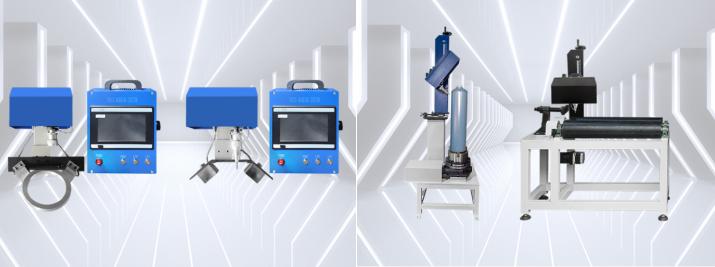
Как работает процесс маркировки цилиндров
Процесс маркировки цилиндров - это тщательно выверенная последовательность шагов, направленная на обеспечение точного нанесения необходимой информации на цилиндрические поверхности. Этот процесс обычно включает в себя подготовку, ввод данных, нанесение маркировки, контроль качества и окончательный контроль. Вот более подробный обзор каждого из этих этапов:
- Подготовка: Перед началом маркировки цилиндр должен быть правильно закреплен в станке, чтобы предотвратить его перемещение. Цилиндры обычно зажимаются или удерживаются на месте с помощью специальных приспособлений, которые могут учитывать их изогнутую форму, обеспечивая стабильность маркировочной поверхности. Это особенно важно для точности маркировки, поскольку даже незначительное смещение положения цилиндра может привести к перекосу или искажению конечной маркировки.
- Ввод данных: Затем оператор или автоматизированная система вводят необходимые данные, такие как серийные номера, штрих-коды или текст, в блок управления машины. Современные маркировочные машины позволяют осуществлять точное программирование, в том числе определять расположение, глубину и местоположение каждой метки. Некоторые машины подключены к базам данных, что позволяет автоматически извлекать необходимые данные, что особенно полезно при крупносерийном производстве.
- Маркировка исполнения: Фактический метод маркировки зависит от типа машины. Например:
- Машины для лазерной маркировки Для вытравливания данных на поверхности используется высокоинтенсивный лазерный луч. Лазер точно направляется блоком управления станка, который при необходимости может поворачивать цилиндр, чтобы покрыть всю его окружность.
- Маркировочные машины С помощью стилуса на цилиндре делаются крошечные, близко расположенные друг к другу углубления. Стилус направляется рукой, управляемой компьютером, чтобы создать читаемый текст или цифры.
- Струйные маркировочные машины Распыление чернил в форме знаков или символов непосредственно на поверхность цилиндра, идеально подходит для маркировки неметаллических материалов.
- Контроль качества: After the mark is applied, many machines have built-in sensors or cameras to assess the quality. These systems check for readability, alignment, and adherence to the specified standards, alerting operators if there’s an error.
- Окончательная проверка: После контроля качества баллоны подвергаются окончательной проверке, чтобы убедиться, что вся маркировка соответствует требуемым стандартам. Это может включать в себя проверку человеком, особенно в отраслях, критичных к безопасности. После проверки баллон готов к использованию или отгрузке и снабжен постоянной, отслеживаемой маркировкой.
Этот процесс, разработанный с точностью на каждом этапе, гарантирует точность, читаемость и соответствие маркировки отраслевым нормам.
Отрасли и области применения машин для маркировки цилиндров
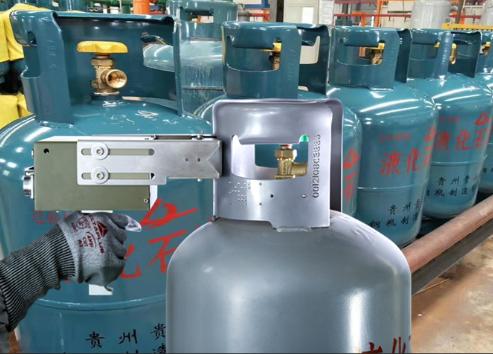
Машины для маркировки цилиндров используются в самых разных отраслях промышленности, каждая из которых имеет специфическое применение:
- Газовый и энергетический сектор: Маркировка на газовых баллонах имеет решающее значение для безопасности, указывая содержимое, номинальное давление и дату проверки. Правильная маркировка помогает предотвратить несчастные случаи и обеспечить соблюдение правил безопасности.
- Производство: В производстве маркировка цилиндров используется для идентификации деталей, отслеживания и контроля качества. Маркировка может помочь в управлении запасами и отслеживании деталей по их производственным партиям.
- Фармацевтическое и медицинское оборудование: В медицинской сфере правильная маркировка оборудования и контейнеров необходима для обеспечения безопасности и соответствия нормативным требованиям. Маркировка часто содержит важную информацию о безопасности и нормативных требованиях.
- Строительная и тяжелая техника: Маркировка труб и трубок, используемых в строительстве, важна для идентификации спецификаций и обеспечения использования правильных материалов в строительных проектах.
В заключение следует отметить, что машины для маркировки цилиндров необходимы во многих отраслях промышленности для нанесения критически важной информации на цилиндрические объекты. Они повышают безопасность и соответствие нормативным требованиям в таких отраслях, как газовая промышленность, производство и здравоохранение. Понимая различные технологии маркировки, предприятия могут улучшить прослеживаемость и поддерживать нормативные стандарты, обеспечивая эффективность работы и безопасность.
Recommended Products

.jpg)
